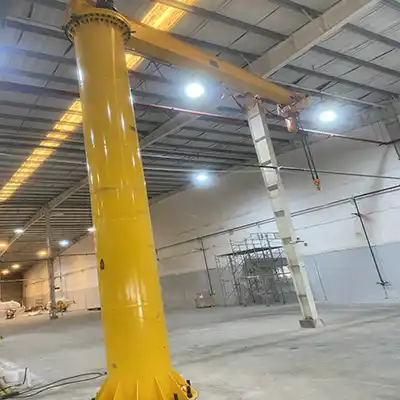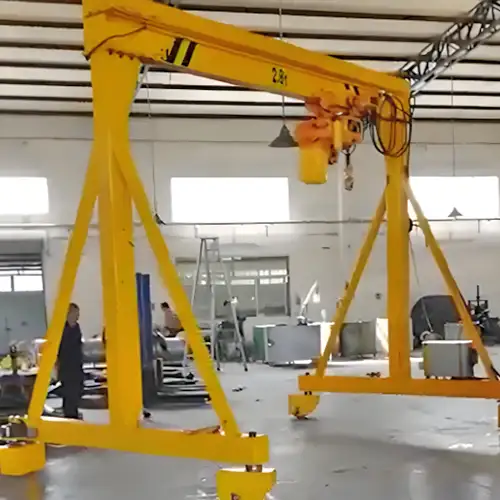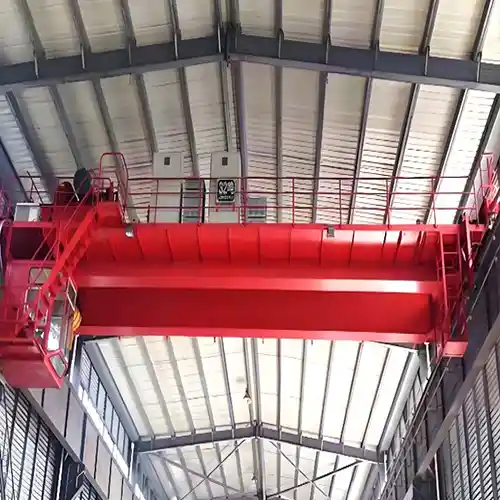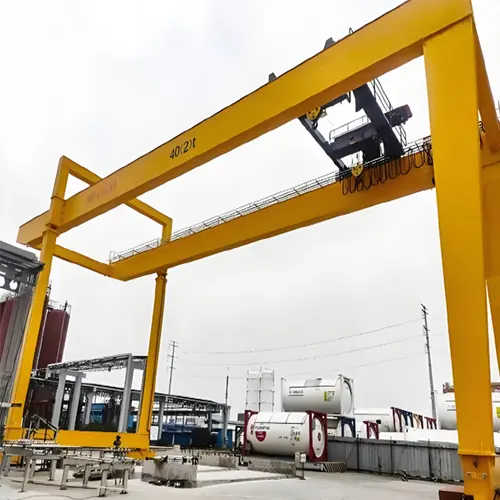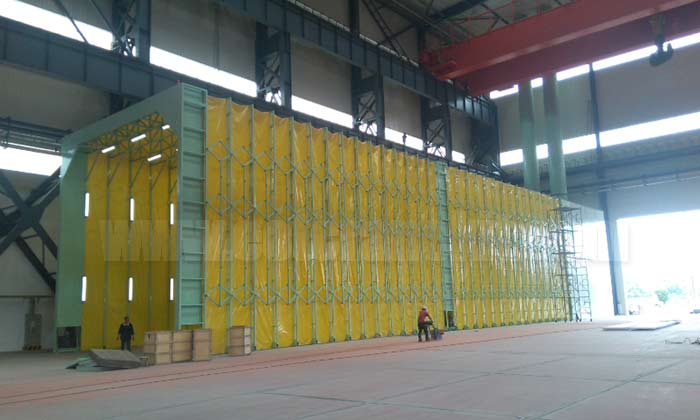
Overhead Cranes and Hoists for Paint Manufacturing & Beyond
Overhead crane, gantry crane, jib cranes and hoists, with single / double girder for paint manufacturing & beyond for indoor & outdoor material handling.
Overview of Paint Manufacturing Industry
The paint manufacturing industry is a sector of the manufacturing industry that produces various types of paints, coatings, and related products used for protective, decorative, and functional purposes. Paints and coatings are applied to surfaces to enhance their appearance, protect them from environmental factors, prevent corrosion, provide insulation, and more.
The industry encompasses a wide range of products, including
- Architectural Paints:These are paints used for buildings, homes, and other structures. They include interior and exterior paints, primers, varnishes, stains, and sealants.
- Industrial Coatings:These coatings are designed for use in industrial settings to protect surfaces from corrosion, abrasion, chemicals, and extreme temperatures. They're used on equipment, machinery, pipelines, and more.
- Automotive Coatings:These coatings are used in the automotive industry to protect and enhance the appearance of vehicles. They include primers, basecoats, clearcoats, and specialty coatings for different automotive parts.
- Aerospace Coatings:These coatings are formulated to meet the unique demands of aerospace applications, providing protection against extreme temperature variations, pressure changes, and corrosive environments.
- Marine Coatings:Marine paints and coatings are used to protect ships, boats, and offshore structures from the corrosive effects of saltwater and harsh weather conditions.
- Specialty Coatings:These coatings are designed for specific applications, such as fire-resistant coatings, anti-graffiti coatings, anti-microbial coatings, and more.
The process of paint manufacturing involves several steps, including
- Raw Material Selection:Paints are made from various ingredients, including pigments, binders (resins), solvents, additives, and fillers. These materials are carefully chosen based on the desired properties of the paint.
- Mixing and Dispersion:The raw materials are mixed and dispersed to achieve a uniform and consistent mixture. This step involves breaking down pigment particles and distributing them evenly in the binder.
- Grinding and Milling:In this step, the mixture is further processed to achieve the desired particle size distribution. This helps improve the paint's performance and appearance.
- Color Development:Paint manufacturers can produce a wide range of colors by adjusting the pigments used and their concentrations.
- Quality Control:Throughout the manufacturing process, quality control measures are taken to ensure that the paint meets specified standards for color, viscosity, durability, and other properties.
- Packaging and Distribution:Once the paint is manufactured and quality-checked, it is packaged in various sizes and containers for distribution to retail stores, wholesalers, or directly to customers.
The paint manufacturing industry involves the production of paints, coatings, varnishes, and other related products used for various purposes, such as decorative, protective, and industrial applications. Paints are formulated by blending different ingredients, including pigments, binders, solvents, additives, and other chemicals, to achieve desired properties such as color, durability, and application characteristics.
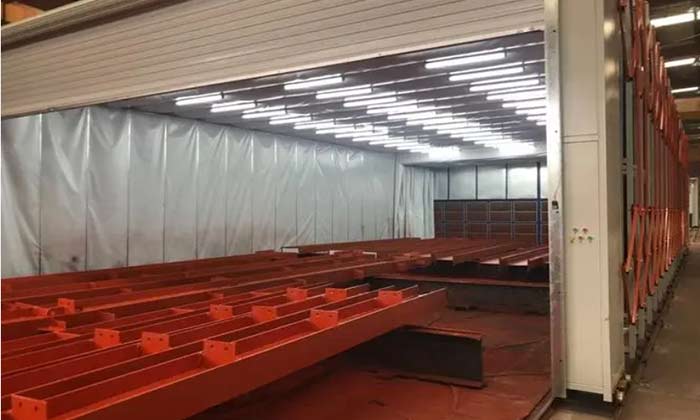
Overhead Cranes in the Paint Manufacturing Industry: Enhancing Precision and Efficiency
Overhead cranes play a crucial role in the paint manufacturing industry by facilitating the movement of heavy materials and components throughout the manufacturing process. These cranes are designed to lift, transport, and position heavy loads in various areas of a paint manufacturing facility. Here's how overhead cranes are used in the paint manufacturing industry
In paint manufacturing, different procedures involve various materials, equipment, and processes. While specific overhead crane types can be used for each procedure, the selection depends on factors such as load capacity, space constraints, and safety requirements. Here's an overview of how different types of overhead cranes can be used in each procedure of paint manufacturing
Raw Material Handling
Overhead cranes are used to transport raw materials such as large containers of pigments, resins, solvents, and other components from storage areas to the mixing and production areas. This ensures efficient material handling and minimizes manual labor.
- Typical Crane Types:Bridge Cranes, Gantry Cranes, Monorail Cranes, Jib Cranes
- Features and Benefits:These cranes offer the flexibility to move raw materials such as pigments, resins, and solvents from storage areas to mixing stations efficiently.
- Typical Functions and Applications:
- Bridge Cranes and Gantry Cranes:Transport large containers of raw materials between storage and production areas.
- Monorail Cranes:Move materials along a fixed path within a specific work area.
- Jib Cranes:Precisely position materials near mixing equipment.
Mixing and Dispersion
In the mixing process, overhead cranes might be used to lift and position containers or tanks that hold raw materials, allowing them to be precisely poured into the mixing equipment. This helps ensure accurate ingredient proportions and efficient mixing.
- Typical Crane Types:Jib Cranes, Articulating Jib Cranes
- Features and Benefits:These cranes provide localized lifting and positioning for accurate material dispensing during the mixing process.
- Typical Functions and Applications:
- Jib Cranes:Lift containers of raw materials to pouring or mixing stations.
- Articulating Jib Cranes:Position materials with precision, especially in areas with obstacles.
Batch Processing
Paint manufacturing involves multiple stages such as grinding, milling, and color development. Overhead cranes can move materials and equipment between these stages, ensuring a smooth and streamlined manufacturing process.
- Typical Crane Types:Bridge Cranes, Gantry Cranes,
- Features and Benefits:These cranes offer the capability to move and position heavy materials and equipment for efficient batch processing.
- Typical Functions and Applications:
- Bridge Cranes and Gantry Cranes:Transfer materials between processing stages such as grinding, milling, and color development.
- Stacker Cranes:Automate the storage and retrieval of materials required for batch processing.
Equipment Maintenance and Repair
Overhead cranes are often used to lift heavy machinery and equipment for maintenance, repair, and replacement. This ensures that the manufacturing process remains uninterrupted and that equipment operates efficiently.
- Typical Crane Types:Bridge Cranes, Gantry Cranes, Jib Cranes
- Features and Benefits:These cranes aid in lifting heavy machinery and equipment for maintenance, repair, and replacement.
- Typical Functions and Applications:
- Bridge Cranes and Gantry Cranes:Lift and position heavy equipment for maintenance work.
- Jib Cranes:Provide localized lifting for equipment maintenance tasks.
Packaging and Distribution
Once the paint is manufactured, overhead cranes can be used to lift and position containers for packaging, labeling, and palletizing. They can also assist in loading finished products onto trucks for distribution.
- Typical Crane Types:Bridge Cranes, Gantry Cranes, Monorail Cranes
- Features and Benefits:These cranes facilitate the packaging and loading of finished products onto trucks for distribution.
- Typical Functions and Applications
- Bridge Cranes and Gantry Cranes:Position containers for packaging and labeling.
- Monorail Cranes:Move finished products along a linear path for loading onto trucks.
Remember that the selection of the appropriate overhead crane type depends on factors such as load weights, lifting heights, available space, and safety regulations within each specific procedure. Customization options, such as adding specialized lifting attachments or using explosion-proof features, can further tailor the cranes to the requirements of the paint manufacturing process. It's essential to work closely with crane manufacturers and engineers to design a lifting solution that optimally supports each procedure's efficiency and safety.
Types of Overhead Cranes Used: Tailoring Lifting Solutions for Paint Manufacturing and Beyond
In the paint manufacturing industry and various other industries, different types of overhead cranes are used to tailor lifting solutions to specific needs. Each type of crane is designed to handle different load capacities, environments, and operational requirements. Here are some types of overhead cranes commonly used in the paint manufacturing industry and beyond
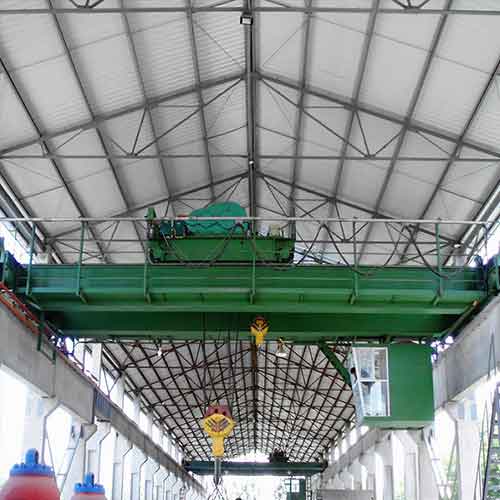
Double girder explosion proof overhead bridge crane for paint manufacturing workshops
Overhead Cranes
- Typical Industry Crane Used:Double Girder Overhead Cranes
- Crane Capacities:Higher load capacity for handling heavy materials and equipment.
Feature
- Two horizontal girders for increased stability and load-bearing capacity.
- Precise positioning and control for accurate material handling.>
- Safety features such as overload protection and collision avoidance systems.
- Suitable for larger spans and heavier loads.
Commonly Used Applications in
- Moving raw materials and finished products within the facility.
- Handling equipment for mixing and blending processes.
- Loading and unloading paint containers onto trucks.
Tailored for the Paint Industry
Double girder overhead cranes are ideal for paint manufacturing due to their ability to handle varying load sizes and weights. They facilitate efficient material movement and positioning during processes like mixing, filling, and packaging, ensuring both productivity and safety in paint-related applications.
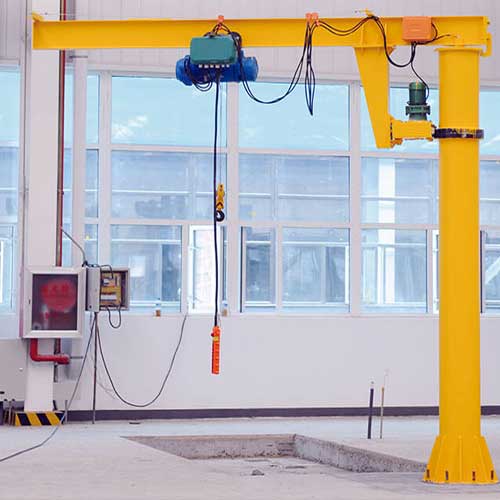
Jib Cranes
- Typical Industry Crane Used:Wall-Mounted Jib Cranes
- Crane Capacities:Suitable for localized material handling and positioning.
Feature
- Rotating arm for precise material placement within a limited area.
- Compact design that saves floor space.
- Versatile mounting options on walls or columns.
- Quick and efficient material handling for smaller loads.
Commonly Used Applications in
- Positioning containers and materials for mixing and blending.
- Assisting in loading and unloading equipment.
- Handling smaller loads in specific workstations.
Tailored for the Paint Industry
Wall-mounted jib cranes are tailored for paint manufacturing by providing localized material handling, such as moving containers for precise ingredient measurement during mixing and facilitating efficient material placement for various processes.

Gantry Cranes
- Typical Industry Crane Used:Full Gantry Cranes
- Crane Capacities:Versatile load capacities for outdoor or indoor applications.
Feature
- Mobile design with legs on rails or wheels for flexible movement.
- Suitable for outdoor use or when overhead space is limited.
- High load capacity for heavy materials and equipment.
- Can cover a wide area for efficient material handling.
Commonly Used Applications in
- Loading and unloading paint containers onto distribution trucks.
- Transporting materials across different sections of the facility.
- Handling larger loads and equipment.
Tailored for the Paint Industry
Full gantry cranes are tailored for paint manufacturing by offering mobility and adaptability. They efficiently assist in loading finished products onto distribution trucks, moving materials within the facility, and supporting various tasks that require substantial load capacity.
Features hoists and cranes for Paint manufacturing industrry
Besides of the main types of overhead crane for manufacturing industry, there are some other types of material handling hoists and cranes for the paint manufacturing industry and beyond industrial sectors
- Monorail Cranes:Monorail cranes consist of a single rail along which a trolley moves. They are suitable for linear material handling within a confined space, often used for assembly lines or specific manufacturing processes.
- Articulating Jib Cranes:These cranes combine the features of jib cranes with articulating arms, allowing for precise lifting and positioning in confined spaces or areas with obstacles.
- Stacker Cranes:Stacker cranes are commonly used in warehouses and storage facilities. They are designed to automatically store and retrieve materials from racks or shelves, increasing storage capacity and efficiency.
- Automated Guided Vehicles (AGVs):AGVs are mobile robots equipped with lifting mechanisms. They are used to move materials within manufacturing facilities without the need for fixed infrastructure like rails or runways.
- Magnetic Cranes:These cranes use electromagnets to lift and move ferrous materials, making them suitable for handling metal components in manufacturing processes.
- Explosion-Proof Cranes:In environments where there's a risk of explosive gases or materials, explosion-proof cranes are designed to ensure safety and prevent sparks that could trigger explosions.
- Clean Room Cranes:Clean room cranes are designed for use in environments where cleanliness and minimal contamination are crucial, such as in pharmaceutical, semiconductor, and certain manufacturing processes.
- Hoists and Trolleys:While not overhead cranes themselves, hoists and trolleys are often integrated with different types of support structures to create lifting solutions tailored to specific needs.
When selecting an overhead crane type for paint manufacturing or any other industry, factors like load capacity, lifting height, operating environment, speed, precision, and safety features need to be considered. Each type of crane offers its own advantages and is suitable for different scenarios. Customization options also allow for tailoring the crane's capabilities to the specific requirements of the application.
Hazardous Substances in Paint Manufacturing & Explosion proof overhead cranes
Paint manufacturing involves the use of various chemicals that can pose health and safety risks to workers if not handled properly. Some hazardous substances found in paint manufacturing include
- Volatile Organic Compounds (VOCs):These are emitted as gases from certain solids or liquids, including solvents used in paints. VOCs can contribute to air pollution and pose health risks to workers.
- Heavy Metals:Some pigments used in paints contain heavy metals such as lead, cadmium, and chromium, which can be toxic if not handled carefully.
- Isocyanates:These chemicals are commonly used in certain coatings and can cause respiratory and skin sensitization issues.
- Solvents:Many paints contain solvents that can be flammable, toxic, or both.
- Particulates:Fine particulate matter, such as pigment dust, can pose inhalation risks.
Preventing Dangers and Ensuring Safety
To prevent dangers associated with paint manufacturing, the following measures are crucial
- Engineering Controls:Implement proper ventilation systems to control fumes, dust, and vapors. Use enclosed systems where possible to minimize worker exposure.
- Personal Protective Equipment (PPE):Provide workers with appropriate PPE, such as respirators, gloves, goggles, and protective clothing, to minimize direct contact with hazardous substances.
- Training:Train workers on the proper handling, storage, and disposal of hazardous chemicals. Emphasize safe work practices and emergency procedures.
- Substitution:Consider substituting hazardous chemicals with safer alternatives where feasible.
- Storage and Labeling:Store chemicals in designated areas with proper labeling. Keep incompatible chemicals separated.
- Emergency Preparedness:Have emergency plans in place, including evacuation procedures and spill response protocols.
Safety Requirements
Regulations and safety requirements vary by country, but common guidelines include
- Compliance with Hazard Communication (HazCom) standards.
- Following Occupational Safety and Health Administration (OSHA) guidelines.
- Adhering to Globally Harmonized System (GHS) labeling and classification.
- Implementing Control of Substances Hazardous to Health (COSHH) regulations.
Paint manufacturing facilities should have dedicated safety officers, regular safety audits, and ongoing training programs to ensure the well-being of workers and the environment.
Explosion proof features
Explosion-proof cranes may be required in certain areas of paint manufacturing and painting workshops where there is a potential for the presence of flammable or explosive substances. These cranes are designed to minimize the risk of igniting hazardous gases, vapors, or dust particles that can lead to explosions in environments with combustible materials. Here are some scenarios where explosion-proof cranes might be necessary
- Spray Booths:In painting workshops, spray booths are often used to apply paint to various surfaces. These booths can create an environment where flammable paint fumes are present. Explosion-proof cranes may be needed to safely handle materials and equipment within the spray booth.
- Solvent Storage and Handling:Paint manufacturing involves the use of solvents and volatile organic compounds (VOCs). Storage areas or handling zones for these materials might require explosion-proof cranes to prevent potential ignition sources.
- Drying and Curing Processes:Some paint application processes involve heat and drying or curing ovens. Explosion-proof cranes might be needed in areas where solvent vapors or paint overspray could be present.
- Areas with Dust Hazard:In facilities where powder coatings or pigments are used, explosion-proof cranes could be necessary due to the presence of combustible dust particles.
- Chemical Mixing and Handling:Certain stages of paint manufacturing involve mixing and handling chemicals that could produce flammable gases or vapors. Explosion-proof cranes may be required to handle containers or equipment in such areas.
It's important to conduct a thorough hazard assessment of the paint manufacturing and painting workshop areas to determine whether explosion-proof cranes are necessary. Regulations and guidelines from organizations such as the Occupational Safety and Health Administration (OSHA) or relevant local safety authorities should be consulted to ensure compliance with safety standards.
If there's a potential for explosive atmospheres in any part of the facility, explosion-proof equipment, including cranes, should be used to mitigate the risk of accidents, ensure worker safety, and prevent damage to property.
Features and Benefits of Overhead Cranes: Empowering Precision and Safety
Overhead cranes aren't just heavy machinery; they are sophisticated tools designed to revolutionize the way materials are handled and paint is applied. In this section, we'll explore the remarkable features and benefits that make overhead cranes essential assets across industries, enabling precise paint application and ensuring operator safety.
Mobility and Flexibility: Navigating the Workspace
- Features:Overhead cranes glide along runways, covering expansive workspaces and reaching areas that might be challenging to access.
- Benefits:Cranes ensure efficient movement of materials and equipment, optimizing material flow and accessibility for paint application.
Lifting Capacities and Load Handling: Power to Lift and Hold
- Features:Overhead cranes are engineered to handle diverse load capacities, from light to heavy, with mechanisms like hoists and trolleys.
- Benefits:They enable safe lifting and transportation of materials of varying weights, ensuring consistent and accurate paint application on a wide range of products.
Precise Positioning and Control: Painting with Accuracy
- Features:Overhead cranes offer precise positioning through mechanisms like end effectors, allowing controlled movement in all directions.
- Benefits:They ensure painters can access intricate areas, apply paint with precision, and achieve uniform coverage across surfaces.
Safety Features and Operator Comfort: Priority on Protection
- Features:Overhead cranes incorporate safety features such as collision avoidance systems, load monitoring, and ergonomic controls.
- Benefits:These features minimize the risk of accidents, enhance operator safety, and promote a comfortable working environment, ultimately boosting productivity.
Remote Control and Automation: Advancing Efficiency
- Features:Overhead cranes can be equipped with remote control systems and automated processes for increased efficiency and reduced manual labor.
- Benefits:Remote control enables operators to control crane movements from a safe distance, while automation streamlines repetitive tasks, optimizing time and resources.
Adaptability to Industry Requirements: Custom Solutions
- Features:Overhead cranes can be customized to suit specific industry needs, with modifications in hoist type, load capacity, and control systems.
- Benefits:This adaptability ensures that each crane is tailored to the demands of the painting process, maximizing efficiency and effectiveness.
Durability and Longevity: Investment in Quality
- Features:Overhead cranes are built to withstand the rigors of industrial environments, with sturdy construction and durable components.
- Benefits:Their longevity reduces maintenance costs and downtime, providing a reliable tool for consistent paint application over the years.
Conclusion: Elevating Efficiency, Safety, and Quality
Overhead cranes represent a pinnacle of engineering excellence, combining advanced features with tangible benefits. Their role in enhancing precision, safety, and overall efficiency in paint application cannot be overstated. As we progress through this guide, we'll delve deeper into how these features and benefits come to life in different sectors, revolutionizing the world of painting and material handling.
Commonly Used Overhead Crane Features: A Symphony of Precision and Innovation
As technology continues to evolve, overhead cranes have become increasingly sophisticated, incorporating a range of features that optimize paint application and material handling. In this section, we'll explore the common features that have transformed overhead cranes into versatile tools, enhancing accuracy, efficiency, and safety.
Hoists, Trolleys, and End Effectors: Precision in Every Move
- Hoists:Hoists are the heart of overhead cranes, providing vertical lifting capabilities. Different types of hoists, such as electric chain hoists or wire rope hoists, cater to varying load capacities and application requirements.
- Trolleys:Trolleys allow horizontal movement along the bridge, ensuring precise positioning of loads for accurate paint application.
- End Effectors:These attachments enhance crane functionality, adapting to specific tasks. From paint applicators to hooks for lifting, end effectors make overhead cranes versatile tools.
Remote Control and Automation: Unleashing Efficiency
- Remote Control:The integration of remote control systems allows operators to maneuver cranes from a safe distance. This feature is especially beneficial in hazardous or hard-to-reach areas, ensuring operator safety while maintaining control.
- Automation:Automation streamlines repetitive tasks, enabling consistent and efficient paint application. Automated cranes can follow predefined paths, optimizing material handling and paint coverage.
Multiple Speed Options: Tailored for Every Task
- Variable Speed Control:Overhead cranes often offer variable speed options, allowing operators to adjust the crane's movement speed to match the demands of different tasks.
- Precision Control:Lower speeds are ideal for intricate paint application, while higher speeds optimize material transportation, saving time without compromising accuracy.
Load Monitoring and Collision Avoidance Systems: Ensuring Safety
- Load Monitoring:Overhead cranes are equipped with load monitoring systems that provide real-time data on the weight being lifted. This prevents overloading and ensures safe lifting and transportation.
- Collision Avoidance:Advanced cranes employ collision avoidance systems, using sensors and detectors to prevent collisions with obstacles, structures, or other cranes.
Ergonomic Operator Interface: Comfort and Control
- User-Friendly Controls:Modern overhead cranes feature ergonomic control interfaces, allowing operators to manage crane movements intuitively and comfortably.
- Enhanced Operator Comfort:A comfortable operator interface reduces operator fatigue, promoting a safer and more productive working environment.
Conclusion: Where Precision Meets Innovation
The evolution of overhead crane features has transformed them into multifaceted tools that enhance precision, safety, and efficiency in paint application and material handling. From remote control to load monitoring, these features work in harmony, enabling operators to achieve exceptional results while adhering to safety standards. As we continue our exploration of overhead cranes in specific sectors, we'll witness how these features are harnessed to create artistry and excellence across industries.
Overhead Cranes in Different Sectors: Elevating Paint Application Across Industries
The paint industry is interconnected with various sectors due to the widespread use of paints and coatings in different applications. Here are some related sectors and typical applications of painting:Construction and Architecture, Automotive, Furniture and Woodworking, Industrial Equipment and Machinery, Marine and Shipping, Aerospace, Consumer Goods, textiles and Fashion, Energy and Infrastructure,etc.
Construction and Architecture
Paints are extensively used for both exterior and interior surfaces of buildings, providing aesthetic appeal and protection against weathering.
- Use of Paint:Paint provides aesthetic appeal to buildings and structures, enhances design elements, and protects surfaces from weathering and degradation. It plays a vital role in enhancing the visual appearance of structures and preserving their integrity against environmental factors.
- Crane Used for Painting Works in Construction and Architecture:Overhead Cranes
- Function of Crane:Overhead cranes are employed in the construction and architecture sector to handle and position painting equipment and materials. They facilitate efficient painting of various surfaces, both interior and exterior, ensuring precise coverage and quality finish. These cranes enable controlled movement of painters and equipment at elevated heights, allowing for thorough and uniform painting applications on walls, ceilings, and other architectural features.
Automotive
Automotive paints are used for vehicles' exterior surfaces, enhancing their appearance while protecting against corrosion and environmental factors.
- Use of Paint:Automotive paint is applied to vehicles to provide visual appeal, brand identity, and protection. It adds vibrant colors, gloss, and metallic effects, while also acting as a shield against rust, UV radiation, and harsh weather conditions.
- Overhead Crane Used for Painting Works in Automotive Sector:Overhead Crane with Manipulator Arm
- Function of Crane:An overhead crane with a manipulator arm is frequently utilized in the automotive sector for efficient and controlled painting processes. This specialized crane system features a manipulator arm that holds the painting equipment, such as spray guns or paint applicators. The crane's precise movement and positioning capabilities enable accurate coating application on vehicles' surfaces.
Benefits and Applications of Overhead Crane with Manipulator Arm
- Precision Painting:The crane's controlled movements ensure uniform paint application on vehicle surfaces, minimizing inconsistencies.
- Optimized Efficiency:The combination of overhead crane mobility and manipulator arm flexibility speeds up painting processes.
- Access to Challenging Areas:The manipulator arm reaches intricate vehicle parts that may be difficult to paint manually.
- Reduced Operator Fatigue:The crane assists painters by reducing the physical strain of holding and maneuvering painting equipment.
- Enhanced Safety:The crane's stability and precise control reduce the risk of accidents during painting.
Commonly Used Applications in Automotive Sector
- Vehicle Painting:Overhead cranes with manipulator arms are used in painting vehicle exteriors during manufacturing, ensuring high-quality finishes.
- Spot Repairs:These systems assist in refinishing specific areas or repairing paint defects on vehicles.
Furniture and Woodworking
- Paints and coatings are applied to furniture, cabinets, and wood products for decorative purposes and protection.
- Use of Paint:Paint is used on furniture and wood products to enhance their visual appeal, create custom designs, and protect against scratches, moisture, and wear. It transforms ordinary wood into aesthetically pleasing and durable pieces.
- Crane Used for Painting Works in Furniture and Woodworking Sector:Jib Crane
- Function of Crane:Jib cranes are utilized in the furniture and woodworking sector for controlled movement of painting equipment over surfaces. These cranes facilitate accurate application of paint on intricate woodwork, cabinets, and furniture components, ensuring smooth finishes and attention to detail.
Benefits and Applications of Jib Crane in Furniture and Woodworking
- Localized Painting:Jib cranes offer precise positioning, allowing painters to focus on specific areas of furniture or wood products.
- Enhanced Efficiency:Painters can easily maneuver the painting equipment, reducing the time required for painting.
- Flexibility:Jib cranes can rotate and extend, providing access to different parts of furniture without the need for repositioning.
- Minimized Worker Fatigue:The crane's support reduces the physical strain on painters, enabling more accurate and consistent painting.
- Quality Finish:Jib cranes contribute to achieving uniform paint application and detailed finishes.
- Commonly Used Applications in Furniture and Woodworking:
- Furniture Painting:Jib cranes are used to paint wooden furniture pieces, ensuring consistent and precise paint coverage.
- Cabinet Finishing:These cranes assist in applying paint to cabinets, ensuring an even coat on surfaces and edges.
- Decorative Woodwork:Jib cranes are employed for painting intricate wood carvings and decorative elements.
Industrial Equipment and Machinery
Coatings protect machinery and equipment from corrosion, chemicals, and mechanical wear.
- Use of Paint:Industrial coatings are applied to machinery and equipment surfaces to prevent corrosion, extend lifespan, and maintain operational efficiency. These coatings create protective barriers against harsh environmental conditions and chemical exposure.
- Crane Used for Painting Works in Industrial Equipment Sector:Overhead Crane
- Function of Crane:Overhead cranes are employed in industrial settings to lift and move large machinery components for painting. They ensure efficient coverage of surfaces, allowing thorough coating application on heavy equipment and machinery parts.
Benefits and Applications of Overhead Crane in Industrial Equipment Sector
- Heavy Load Handling:Overhead cranes can lift and move heavy machinery parts and equipment, making them suitable for industrial applications.
- Precise Positioning:These cranes offer controlled movement, allowing painters to reach specific areas for coating application.
- Optimized Workflow:Overhead cranes improve painting processes by efficiently transporting equipment to designated workstations.
- Reduced Labor Intensity:The crane's capabilities reduce the physical strain on workers during painting tasks.
- Uniform Coating:Overhead cranes ensure consistent paint thickness and coverage on large and complex machinery.
Commonly Used Applications in Industrial Equipment Sector
- Heavy Machinery Coating:Overhead cranes assist in painting large industrial equipment, ensuring protective coatings against wear and corrosion.
- Equipment Maintenance:These cranes are used to move machinery components for maintenance and re-coating purposes.
Marine and Shipping
Marine coatings protect ships and vessels from corrosion and fouling in aquatic environments.
- Use of Paint:Marine coatings are applied to ships' hulls and underwater structures to prevent corrosion, reduce drag, and deter the attachment of marine organisms. These coatings ensure the longevity and efficiency of vessels in demanding maritime conditions.
- Crane Used for Painting Works in Marine and Shipping Sector:Gantry Crane (for Dry Docking)
- Function of Crane:Gantry cranes are used for dry docking ships, providing a platform to access and paint underwater portions of the vessel. These cranes lift ships out of the water, allowing for thorough maintenance, including painting, inspections, and repairs.
Benefits and Applications of Gantry Crane in Marine and Shipping
- Vessel Maintenance:Gantry cranes enable comprehensive maintenance activities, including painting, on underwater sections of ships.
- Efficient Dry Docking:These cranes expedite the process of lifting ships out of the water, optimizing maintenance schedules.
- Protection Against Fouling:Properly applied marine coatings deter the growth of marine organisms on ships' hulls, reducing drag and fuel consumption.
- Commonly Used Applications in Marine and Shipping Sector:
- Ship Painting:Gantry cranes are used for lifting ships during dry docking, enabling access to underwater areas for painting and maintenance.
- Corrosion Prevention:Marine coatings applied during dry docking protect ships from corrosion in aggressive marine environments.
Aerospace
Aviation paints and coatings are used for aircraft exteriors and interiors, ensuring durability and compliance with aviation regulations.
- Use of Paint:Aviation paints and coatings serve multiple purposes in the aerospace industry. They provide protection against aerodynamic forces, temperature fluctuations, UV radiation, and environmental factors. Additionally, they contribute to the visual branding and aesthetic appeal of aircraft.
- Overhead Crane Used for Painting Works in Aerospace Sector:Overhead Crane with Paint Trolley
- Function of Crane:An overhead crane with a paint trolley is commonly used in the aerospace sector for aircraft painting. The paint trolley holds the paint applicators, allowing controlled movement over aircraft surfaces. The overhead crane system facilitates precise and efficient paint application on both exteriors and interiors of aircraft.
Benefits and Applications of Overhead Crane with Paint Trolley in Aerospace
- Uniform Coating:The controlled movement of the paint trolley ensures consistent paint thickness and coverage, meeting aerospace standards.
- Optimized Workflow:Overhead cranes with paint trolleys enable efficient movement of painting equipment along the aircraft's length.
- Safety:Painters are positioned safely above the aircraft, reducing exposure to hazardous materials.
- Aircraft Aesthetics:Precise application enhances the appearance and branding of aircraft.
- Quality Control:The crane system ensures accurate and compliant paint application.
Commonly Used Applications in Aerospace Sector
- Aircraft Exterior Painting:Overhead cranes with paint trolleys are used to apply paint to aircraft exteriors, achieving high-quality and protective coatings.
- Interior Component Painting:These crane systems assist in painting interior components of aircraft, ensuring consistent finishes and meeting regulations.
Textiles and Fashion
Fabric paints and coatings allow customization and design on clothing, accessories, and home textiles.
- Use of Paint:Fabric paints and coatings are used to create unique designs, patterns, and artwork on various textile products. They offer a way to personalize clothing, accessories, and home textiles while adding creative and aesthetic elements.
- Hoists and Cranes Used for Painting Works in Textiles and Fashion Sector:Articulating Jib Cranes
- Function of Hoists and Cranes:Articulating jib cranes are commonly utilized in the textiles and fashion sector for controlled movement of painting equipment over fabric surfaces. These cranes assist in precise and artistic paint application on textiles, ensuring detailed designs and patterns.
Benefits and Applications of Articulating Jib Cranes in Textiles and Fashion
- Artistic Flexibility:Articulating jib cranes allow controlled movement for detailed and intricate fabric painting.
- Efficient Workflow:These cranes enable painters to work on larger fabric pieces without the need for manual handling.
- Minimized Strain:The crane's support reduces physical effort during the painting process, enhancing painter comfort.
- Consistent Design:Articulating jib cranes ensure uniformity in design and pattern application across fabric surfaces.
- Commonly Used Applications in Textiles and Fashion Sector:
- Custom Clothing:Articulating jib cranes assist in painting custom designs on clothing, creating unique garments.
- Accessories:These cranes are employed to add artistic elements to accessories like bags, scarves, and hats.
- Home Textiles:Articulating jib cranes facilitate fabric painting on home textiles such as curtains, pillow covers, and tablecloths.
Energy and Infrastructure
Coatings are used to protect energy infrastructure, pipelines, bridges, and industrial structures from corrosion, chemical exposure, and environmental factors.
- Use of Paint:Coatings play a critical role in the energy and infrastructure sector by providing protection against corrosion, chemical attacks, and harsh environmental conditions. They extend the lifespan of structures, reduce maintenance costs, and ensure the integrity of critical infrastructure.
- Hoists and Cranes Used for Painting Works in Energy and Infrastructure Sector:Full Gantry Cranes
- Function of Hoists and Cranes:Full gantry cranes are commonly employed in the energy and infrastructure sector for efficient painting of large structures, industrial equipment, and infrastructure components. These cranes provide the necessary lifting capacity and mobility to access various parts of structures.
Benefits and Applications of Full Gantry Cranes in Energy and Infrastructure
- Versatile Mobility:Full gantry cranes can move along rails or wheels, allowing access to different areas of structures.
- High Load Capacity:These cranes can handle heavy equipment, making them suitable for industrial infrastructure painting.
- Efficient Painting:Gantry cranes facilitate complete coverage of large surfaces, optimizing painting processes.
- Reduced Downtime:Efficient painting with gantry cranes reduces maintenance downtime for structures and equipment.
- Enhanced Safety:Gantry cranes ensure safe access to elevated areas, minimizing risks for painters.
Commonly Used Applications in Energy and Infrastructure Sector
- Industrial Structures:Full gantry cranes are used for painting industrial buildings, tanks, and other large structures.
- Bridges and Infrastructure:These cranes assist in painting bridges, overpasses, and infrastructure components, protecting against corrosion and wear.
- Pipelines and Energy Equipment:Gantry cranes are employed for painting pipelines, energy equipment, and facilities to prevent corrosion and ensure longevity.
Typical Hoist and cranes used for different painting applications:
Decorative Painting
- Decorative Painting:1* Enhancing aesthetics of walls, ceilings, furniture, and decorative items.
- Typical Crane Used:Jib Crane
- Function:Jib cranes can be used for controlled movement of painting equipment over specific areas on walls, ceilings, furniture, and decorative items, ensuring precise application.
Protective Coatings
- Protective Coatings:Using paints to display logos, product names, and branding information.
- Typical Crane Used:Overhead Crane
- Function:Overhead cranes facilitate the handling and positioning of heavy materials during the application of protective coatings on surfaces that need to be shielded from environmental factors, corrosion, and wear.
Product Branding
- Product Branding:Using paints to display logos, product names, and branding information.
- Typical Crane Used:Gantry Crane
- Function:Gantry cranes are used to lift and position larger items, such as industrial products, for branding and logo application, ensuring accuracy and visibility.
Surface Finishing
- Surface Finishing:Applying coatings to achieve desired finishes like matte, gloss, or textured surfaces.
- Typical Crane Used:Articulating Crane (Knuckle Boom Crane)
- Function:Articulating cranes provide flexibility in reaching and applying coatings to surfaces with varied textures and finishes, achieving the desired matte, gloss, or textured appearance.
Corrosion Prevention
- Corrosion Prevention:Applying anti-corrosive coatings to metals and structures.
- Typical Crane Used:Gantry Crane
- Function:Gantry cranes handle the movement of materials and equipment needed for applying anti-corrosive coatings to metals and structures, ensuring effective protection against corrosion.
Waterproofing
- Waterproofing:Coating surfaces to prevent water infiltration and damage.
- Typical Crane Used:Jib Crane
- Function:Jib cranes assist in precise application of waterproof coatings to surfaces, ensuring even coverage and protection against water infiltration and damage.
Marking and Signage
- Marking and Signage:Creating road markings, traffic signs, and safety signs.
- Typical Crane Used:Overhead Crane
- Function:Overhead cranes handle the positioning of materials required for creating road markings, traffic signs, and safety signs, ensuring accurate and visible markings.
Automotive Refinishing
- Automotive Refinishing:Repairing and repainting vehicles after accidents or wear.
- Typical Crane Used:Jib Crane
- Function:Jib cranes facilitate the movement of vehicles and parts during the refinishing process, allowing controlled application of paint for repairing and repainting.
Art and Creativity
- Art and Creativity:Creating visual art using various painting mediums.
- Typical Crane Used:Articulating Crane (Knuckle Boom Crane)
- Function:Articulating cranes provide artists with the flexibility to reach various angles and positions when creating visual art using different painting mediums.
Specialty Coatings
- Specialty Coatings:Applying coatings with specific properties like fire resistance, thermal insulation, or chemical resistance.
- Typical Crane Used:Gantry Crane
- Function:Gantry cranes handle the materials and equipment needed for applying specialty coatings with specific properties, such as fire resistance, thermal insulation, or chemical resistance.
Anti-Fouling
- Anti-Fouling:Coating ship hulls to prevent marine organisms from attaching.
- Typical Crane Used:Gantry Crane
- Function:Gantry cranes handle the movement of materials and equipment for applying anti-fouling coatings to ship hulls, preventing marine organisms from attaching.
Rust Protection
- Rust Protection:Applying coatings to metal surfaces to prevent rust formation.
- Typical Crane Used:Overhead Crane
- Function:Overhead cranes handle the positioning of materials for applying rust protection coatings to metal surfaces, preventing rust formation.
Wood Preservatives
- Wood Preservatives:Protecting wood from decay, insects, and weather.
- Typical Crane Used:Jib Crane
- Function:Jib cranes assist in the application of wood preservatives to protect wood from decay, insects, and weather.
Packaging
- Packaging:Using coatings on packaging materials for branding and labeling.
- Typical Crane Used:Gantry Crane
- Function:Gantry cranes handle the loading and unloading of materials used for applying coatings on packaging materials for branding and labeling.
High-Temperature Coatings
- High-Temperature Coatings:Coating surfaces exposed to extreme heat or thermal cycling.
- Typical Crane Used:Articulating Crane (Knuckle Boom Crane)
- Function:Articulating cranes provide flexibility in reaching and applying high-temperature coatings to surfaces exposed to extreme heat or thermal cycling.
These crane choices align with the specific requirements of different painting applications, ensuring efficiency, accuracy, and safety in the overall process.
Safety Considerations and Regulations: Prioritizing Protection in Overhead Crane Operation
Safety is paramount in any industrial operation, and the use of overhead cranes is no exception. In this section, we'll delve into the significance of safety in overhead crane operation, the importance of adhering to occupational health and safety guidelines, and the crucial role of compliance with industry regulations.
Importance of Safety in Overhead Crane Operation:A Non-Negotiable Priority
Safety takes precedence above all else when operating overhead cranes. These machines handle heavy loads and operate in close proximity to workers, making safety measures critical. The consequences of accidents can be severe, both in terms of human lives and operational disruptions.
Occupational Health and Safety Guidelines:Protecting the Workforce- Training:Proper training for crane operators is essential. Operators should understand crane controls, load limits, emergency procedures, and safe practices.
- Maintenance:Regular maintenance ensures cranes are in optimal condition, minimizing the risk of breakdowns or malfunctions during operation.
- Clear Communication:Establish clear communication protocols between crane operators and ground personnel, ensuring safe movements and load transfers.
Compliance with Industry Regulations: Legal and Ethical Responsibility
- OSHA Guidelines:In the United States, the Occupational Safety and Health Administration (OSHA) provides guidelines for overhead crane operation. Compliance with OSHA standards ensures a safe work environment and prevents legal penalties.
- International Standards:Various international standards organizations, such as ISO and ANSI, also offer guidelines for crane safety. Adhering to these standards ensures consistent safety practices on a global scale.
Operator Comfort and Ergonomics: A Vital Component of Safety
- Ergonomic Controls:Operator comfort plays a significant role in safety. Ergonomic crane controls reduce operator fatigue, enhancing concentration and precision.
- Visibility:Clear visibility from the operator's cabin ensures that crane movements can be monitored effectively, minimizing the risk of accidents.
Load Monitoring and Safety Devices: Real-Time Protection
- Load Monitoring:Real-time load monitoring prevents overloading, a common cause of crane accidents. It ensures that cranes lift within safe load limits.
- Collision Avoidance Systems:Collision avoidance systems use sensors to detect obstacles and prevent collisions, safeguarding workers and equipment.
Emergency Procedures and Response Training: Preparedness Saves Lives
- Emergency Plans:Well-defined emergency procedures should be in place, covering scenarios such as power failures, malfunctions, or accidents.
- Response Training:Operators and personnel should be trained to respond swiftly and appropriately in emergencies, minimizing risks and ensuring quick and effective interventions.
Conclusion: The Foundation of Safe and Efficient Operations
Safety considerations and regulations form the bedrock of successful overhead crane operations. Adherence to guidelines, proper training, and the implementation of safety measures safeguard workers, prevent accidents, and maintain operational continuity. As we delve deeper into the application of overhead cranes in various sectors, we'll witness how a safety-conscious approach underpins their seamless integration into the painting process.
Maintenance and Inspection: Ensuring Peak Performance and Safety
The reliability and safety of overhead cranes depend on diligent maintenance and regular inspections. In this section, we'll delve into the critical aspects of routine maintenance, servicing, and the importance of thorough inspection schedules to ensure both optimal crane performance and safe operations.
Routine Maintenance and Servicing: The Backbone of Reliability
Routine maintenance is the cornerstone of maintaining overhead crane reliability. Scheduled servicing keeps cranes in peak condition, minimizing downtime, and ensuring smooth and efficient operation.
- Lubrication:Regular lubrication of moving parts prevents wear and tear, reduces friction, and extends the lifespan of crucial components.
- Component Inspection:Systematic inspection of hoists, trolleys, end effectors, and controls detects early signs of wear or malfunctions, enabling timely repairs.
- Electrical Checks:Thorough inspection of electrical components and wiring safeguards against electrical failures that could disrupt crane operation.
Inspection Schedules and Practices: Preventing Compromises to Safety
- Pre-Operation Checks:Operators should conduct pre-operation checks before using cranes, ensuring that all systems are functional and safe for use.
- Frequent Inspections:Regular visual inspections by trained personnel identify potential issues, such as loose bolts, misaligned components, or signs of corrosion.
- Periodic Inspections:More in-depth inspections should be performed at specified intervals, focusing on critical components and mechanisms.
Importance of Documentation:Tracking Maintenance and Inspections
- Maintenance Logs:Keeping detailed maintenance records helps track service history, making it easier to identify patterns and plan future maintenance.
- Inspection Reports:Documentation of inspection findings helps identify trends, enabling proactive measures to address recurring issues.
Training for Maintenance and Inspection Personnel:Expertise is Key
- Training:Technicians responsible for crane maintenance and inspection should receive comprehensive training to identify issues accurately and perform necessary repairs.
- Qualifications:Technicians should be certified to handle specific crane types and components to ensure proper servicing and safety.
Addressing Repairs Promptly: Preventing Escalation of Issues
- Prompt Action:If an issue is detected during inspection, immediate action should be taken to address the problem. Delaying repairs could lead to further damage or safety risks.
Collaboration with Manufacturers and Experts: Expert Guidance
- Manufacturer Guidelines:Consult manufacturer guidelines and recommendations for maintenance and inspection practices specific to each crane model.
- Expert Advice:Seek advice from crane experts and professionals for guidance on complex issues or specialized components.
Conclusion: Proactive Care for Uninterrupted Performance and Safety
The health and longevity of overhead cranes are intrinsically tied to systematic maintenance and diligent inspections. By implementing routine servicing, adhering to inspection schedules, and addressing repairs promptly, industries ensure that their cranes operate optimally and safely. As we navigate through this guide, we'll uncover how a commitment to maintenance and inspection underpins the successful integration of overhead cranes into painting processes across diverse industries.
Overhead cranes have emerged as indispensable tools in the pain manufacturing industry and related sectors. They enable precise paint application, efficient material handling, and enhanced safety. These cranes have revolutionized the way we approach paint finishes, from exterior skyscrapers to intricate machinery components. Their versatility spans industries, ensuring consistent and high-quality outcomes.
